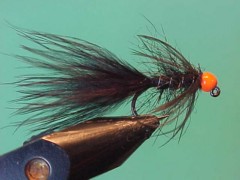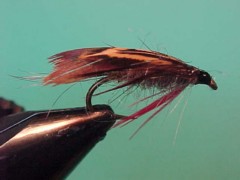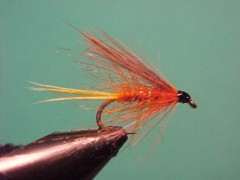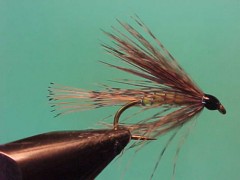Flies
{{start}}
{{end}}

{{+1}}Taihape tickler (aka Tie happy tickler){{-1}}
{{start}}
This fly is similar to a Craig's nightime but in my view has a wider day time application. The Craig's is highly respected as a night time fly when mudeyes are around whereas this fly works well in that situation but also more than holds its own during daylight hours during when either mudeyes or midge are around. Why it works when fish are on midge is any ones guess but it does.{{end}}

{{+1}}Claret hopper{{-1}}
{{start}}
A popular fly in the United Kingdom this fly is equally at home early and late in the season in Australia. We don't have any burgundy coloured hoppers that I am aware of but this buggy looking fly often works when the first and last of the seasons terrestrials are around. Whilst not a strong floater this fly ticks all the boxes for those that want an enticing fly that will sit in the surface film.{{end}}

{{+1}}Tea tree beetle – variant 2{{-1}}
{{start}}
Both floating and wet beetles (including drowned terrestrials beetles and aquatic beetles) should be fished in the current with as little line drag as possible or with a very short twitching action. A nondescript well tied beetle pattern if presented in the right way when fish have beetles on their menu, more often than not, will be accepted by fish.{{end}}

{{+1}}Tea tree beetle – variant 1{{-1}}
{{start}}
One species that is a popular food source for trout is the tea tree beetle. This representation is tied in shades of black and brown colours that have stood the test of time. Many of the recipes you see use brown raffia as the wing case. I don't like raffia as a fly tying material and have substituted a hackle from the back of the ring neck pheasant. Its a similar colour to many of the recipes that have come before mine but its much more durable than the raffia.{{end}}

{{+1}}Geehi beetle{{-1}}
{{start}}
One of the key elements of this fly that has been overlooked in many fly patterns I have seen id the choice of the front hackle. Make sure its a 'cocky-y-bonddu' type hackle i.e. a ginger hackle with a black centre. The black centre of the hackle when wound in touching turns to the eye of the hook extends the beetle body along the full length of the shank of the hook and I an confident that is one of the keys to the success of this fly.{{end}}

{{+1}}River Jig Bugger – CDC orange TBH and black{{-1}}
{{start}}
This is really good representation of a woolly bugger for river fishing. It sinks well and the jig hook encourages the fly to bounce along the bottom hook point up which of course mitigates snags. Whilst I have set the recipe out below for the brown, black and olive jig buggers I also tie my sparkle bugger and skirted buggers in the form of a jig bugger as shown in the photos below.{{end}}

{{+1}}Murdoch{{-1}}
{{start}}
Another old fly this little beauty has its origins on the salmon and trout streams of Ireland probably around the 1820's. Its alternative name of 'hares ear and red' gives away its ancestry. Early versions of the fly presented were no more than a gold ribbed hares ear with a woodcock type wing tied on top. Over time the recipe has evolved.{{end}}

{{+1}}Dunkeld – Chatto’s fuzzeled variant{{-1}}
{{start}}
The Dunkeld is certainly one of my top 5 middle dropper flies for lock style fly fishing. Until 18 months ago I was using a version of the Dunkeld that had a hackle Palmered along the body as in the original. At that time I was experimenting with "fuzzeled" bodies an an alternative to bodies with a Palmered hackle and applied that technique to this fly with immediate success.{{end}}

{{+1}}Bredbo variant MK2 – Chatto’s original{{-1}}
{{start}}
The MK2 is a great alternative middle dropper lock fly to my tie of a Dunkeld for those bright full sun days and also a very formidable wee wet for faster or discoloured rivers.{{end}}

{{+1}}Bredbo variant MKI – Chatto’s original{{-1}}
{{start}}
The Bredbo fly is accredited as being the first Australian designed and made fly and whilst the originator is not known with certainty there is highly persuasive evidence that suggests that it was conceived around 1896 as a grass hopper imitation for targeting fish on the Bredbo river just outside of Cooma NSW. The evidence points to the fly being created by Mr C.R. Burnside and Dr A.J. Brady who along with Howard Joseland are amongst the pioneers of fly fishing for trout in New South Wales .{{end}}













